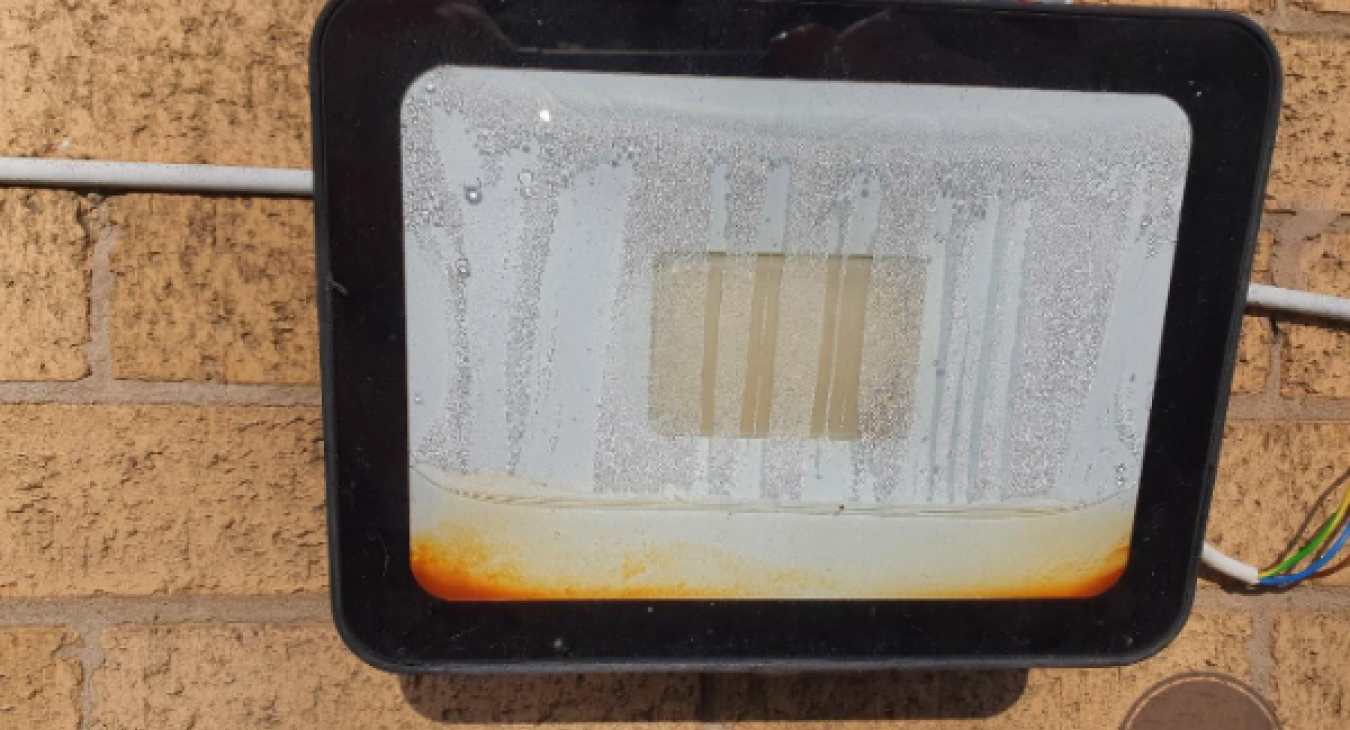1) Why does water end up in these lights?
We all have outdoor spaces that require extra illumination and a great way of achieving this is with a security floodlight or combined floodlight cam for extra security at the same time. When any light is installed for outdoor use, we must consider the possibility of water ingress, especially during periods of heavy rain.
You can easily end up with WATER IN A FLOOD LIGHT if any of the following has occurred:
- Incorrect IP rating
- Missing Protective Covers
- Installation instructions not followed
- Edges of the light fixture damaged
2) What is an IP rating?
IP rating stands for INTERNATIONAL PROTECTION or INGRESS PROTECTION and is displayed on electrical products as IPXX where XX are two numbers indicating the protection the device offers against particle ingress and water ingress.
The higher the IP rating the more resilient the equipment is to dust and water. The highest IP rating is currently IP69 in April 2024. If a product is rated as IP69 then it is completely sealed against dust and high temperature water jets.
IP69 is fairly uncommon at the moment and the highest IP rating that can be found on readily available products is IP68 which is more than sufficient for all but the most severe of electrical equipment installation locations.
If your equipment has an insufficient rating for the environment in which it is installed then there is a likelihood that the equipment will succumb to dust and water ingress.
Back to top3) Missing Protective Covers
On a security floodlight there are often not many protective covers. One exception to this is the cable entry point on the floodlight. Nearly every security floodlight has a cable gland that protects the flood light from water and dust entering. If part of this gland is missing then there is likely to be an issue.
A cable gland is comprised of a few parts:
- The body of the gland which is fixed to the electrical item
- The gland insert, which compresses onto the cable by force from the;
- Gland screw nut which tightens to compress the insert and form a water tight seal
If any of these parts are missing then the gland will not meet its own IP ratings.
There may be other protective covers that the manufacturer provides that maintain the IP rating of the device from dust and rain water. If any of these covers are provided then they should be used in accordance with the manufacturers’ instructions.
Back to top4) Installation Instructions
When we neglect to follow installation instructions for any outdoor electrical products then we are potentially inviting water damage, electrical shock risk and other hazards into our electrical system.
The inconvenience of water ingress can mean that the WHOLE ELECTRICAL INSTALLATION becomes affected. This occurs in cases where the MAIN SWITCH is one that offers electric shock protection.
Always check the installation instructions for the product you have purchased as they will ensure that despite any long periods of direct exposure to water, the product is able to withstand the moisture.
A common mistake that is made when installing outdoor products is to fit them at an incorrect angle which results in too much water attacking the product from and angle that was never meant to be exposed.
Back to top5) Edges of the light fixture compromised
Around the edges of each security light there are normally some seals that prevent any moisture or dust from entering the light fixture. Should there be damage to the edge of the light fixture or the seals then the IP rating of the fixture would be compromised resulting in moisture ingress and failure of the product. During rain over an extended period of time or flash floods, the damage and moisture ingress would be accelerated. Electricians often experience an upturn in emergency calls during times of inclement weather.
Back to top6) Summary
No light fixture is zero maintenance. Regular cleaning and inspection should be carried out to ascertain if there are any issues with the product and to prevent WATER IN A FLOOD LIGHT.
Take a closer look at the gland area, the edges of the fixture and ensure that there is a drip loop on the electricity supply cable to the fixture. A drip loop allows water to drip off without continuing down the cable and entering the light fixture over time.
Even a very small hole in the gland, edge of the fixture or on the body of the light fixture can create a problem and compromise the level of protection against water.
Read more articles
- Log in to post comments


